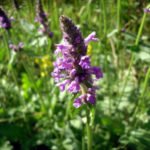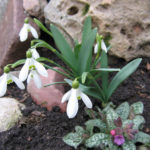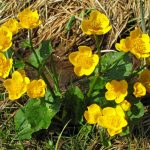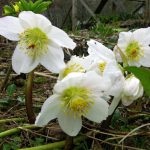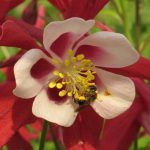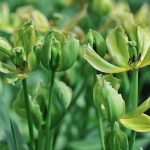The touching beauty of Polygonatum is incomparable. The plant has such a simple appearance, but at the same time-such an expressive personality that it can not be confused with either Campanula, Convallaria, or other flowers.
I first saw her when I was at school, walking in the woods. My mother told me then that it was Polygonatum, and then added that it was also called Solomon’s seal. And since I was very interested in the second name, I began to search with enthusiasm for the history of its origin in books. And here’s what I found out. It turns out that the second name of the plant was due to an interesting rhizome: knotted, with rounded marks — “seals” that remain at the place of attachment of the stem.

Let me remind you that it was the wise Jewish king Solomon, who lived almost 1 thousand years before our era, who invented the first seal.
Botanical dossier
The genus Polygonatum is from the Convallariaceae/Liliaceae family; some taxonomists place it in the Asparagaceae family. It is represented by perennial herbaceous rhizomatous plants with drooping stems 15-70 cm high. Leaves are green (below — grayish-green), quite large, 8-14 cm long, oblong-ovate or elliptical. The flowers are whitish, located in the leaf axils, and bloom in April-June. The fruits are bluish-black berries that ripen in July and August.

Often growers divide all Polygonatum into 2 large groups:
- First Group – species with an erect stem, narrow lanceolate leaves, flowers in their axils (Polygonatum verticillatum, Polygonatum stenophyllum and others);
- Second Group – species with arched shoots, oval leaves, flowers hanging from the leaf axils (Polygonatum odoratum, Polygonatum multiflorum, Polygonatum hirtum, Polygonatum humile).
Most Polygonatum species have small tubular or bell-shaped flowers of white, greenish-white, cream color. However, the miniature Polygonatum hookeri, which is only 10 cm high, boasts charming pink flowers.

And how unusual and exotic are Polygonatum with brighter flowers!

These are Polygonatum stewartianum, 20-90 cm high, with purple-pink flowers, and Polygonatum kingianum with red flowers. The critical winter minimum of this exotic is from -15°From -28°C.
Polygonatum odoratum, syn. Polygonatum officinale
It is found among shrubs, in clearings, clearings, in forest ravines of the forest and forest-steppe zone of the European part. It grows in light-coniferous pine and deciduous forests, in birch forests of the southern part of the forest zone and in the Northern steppes. In mixed and broad-leaved (beech, hornbeam, oak) forests, you can find 2 fairly similar species: Polygonatum multiflorum (flowers about 1.5 cm long, sit 3-5 PCs.) and Polygonatum odoratum (flowers larger than the previous species, 2-2.5 cm long, 1-2 PCs. on short peduncles). Their main difference, as you understand, is in the number of flowers.

A perennial herbaceous rhizomatous plant with a height of 20-50 cm, numerous glabrous leaves are quite large, oblong-elliptical, alternate, double-rowed, with arched curved veins.

Tubular flowers with a delicate scent of lilies, white, with greenish denticles, up to 3 cm long, arranged 1-2 on drooping short pedicels; bloom in April-may. The fruits are spherical bluish-black berries; they ripen in June-August.
Decorative varieties and varieties
- ‘Flore Pleno’ (double flowers, with a wide green border);

- ‘Gilt Edge’ (leaves with a narrow yellow border);

- var. pluriflorum ‘ Variegatum’ (30-60 cm high, leaves with a white border).

Warning: all parts of Polygonatum are poisonous, especially the fruit, which should never be tasted!
Polygonatum multiflorum
It is found in the forests of the European part, in the Caucasus. The plant is about 25 cm wide and can reach 90 cm in height (higher than Polygonatum odoratum). It differs in two-row placement of leaves. Flowers are arranged in 3-5 pieces.

Flowers up to 1 cm long are smaller than those of Polygonatum odoratum.
Decorative variety ‘Striatum’ (leaves with cream-white stripes).

Polygonatum verticillatum
It grows in shady forests, at an altitude of 1500-1800 meters above sea level.

It is also common in varieties in the culture of flower beds, but is not grown in all gardens and parks.
Polygonatum hirtum, syn. Polygonatum latifolium
On the summer beds of Polygonatum lovers, you can also find the most drought-resistant Polygonatum hirtum, 50-60 cm high.

How to grow Polygonatum in the country
Polygonatum are not capricious, although they prefer loose, fertile soil. Preferably wet — but can be content with watering only in the driest summer period. Polygonatum hirtum can develop well and flower in ascetic conditions (shade, compacted soil, lack of moisture). And Polygonatum odoratum will feel good in lighted areas.
Landing site
If the planting material is plentiful, it is better to plant Polygonatum in small groups, adhering to the distance between the plants of 20 cm (planting density-12 PCs. per 1 m²).

Over time, they grow and form free-form beds. They can grow in one place for more than 15 years without transplanting.
Organization of wintering
In winter, some gardeners cut Polygonatum, leaving 5 cm, and mulch the base.
Breeding methods
Propagate mainly vegetatively, by division (pieces of rhizome with several kidneys). It is advisable to prepare a place for planting Polygonatum in advance. The optimal planting time is the end of summer, the beginning of autumn, when the heat subsides.
But if you get your hands on Polygonatum seeds, don’t get lost:
- perform cold stratification of seeds for 1 month;
- surface sowing, in April, immediately to a permanent place (with a designation not to forget and not to lose);
- at a temperature of +10…+16°C, seedlings will appear in 3 months (in General, seeds can germinate within a year);
- seedlings bloom on the 3rd or 4th year.
Polygonatum are resistant to diseases and pests, but can be damaged by slugs, root onion mites, onion flies and affected by white rot, rust, leaf nematode.
Versatile advantages of Polygonatum
These are not only decorative perennials for shade compositions, but also food, medicinal, and honey-bearing species. They eat boiled fleshy rhizomes rich in starch and sugar, and young shoots (like asparagus).

For medicinal purposes, rhizomes are used that have an analgesic (when applied externally) effect; inside they are used for coughing, acute bronchitis, pneumonia, dropsy, diabetes, sexual impotence, gastrointestinal diseases, helminthiasis.
Polygonatum are effective in cutting, they stand in the water for a long time.

Placement in the country
Like Hosta, Polygonatum is a true Queen of shadow. This is an exquisite decorative leafy plant that decorates its flowering or leaves of variegated forms in secluded places in the garden. Polygonatum perfectly fit into the design of not only a mixborder, but also a reservoir, located in a shady corner of the coastal wet zone. In the composition, they will perform a filling or accompanying role.
Polygonatum Partners:
- Dicentra;
- Hosta;
- Heuchera;
- Tiarella;
- Brunnera;
- Omphalodes and others.
Does Polygonatum grow in your cottage yet? Then by all means settle this exotic beauty in a shady flower garden.


